“Double-stack, 9mm, polymer-framed, striker-fired semi-automatic pistol.” If you’ve picked up a gun mag in the past 20 years, you likely found an article based on a gun that fits that description. You might even turn the page because you’re so tired of reading about these. However, companies like Canik and its METE SFT and SFx continue to revitalize the market.
The Canik METE SFx and SFT
If you’re a true firearms enthusiast, then you see the polymer-framed, striker-fired semi-automatic platform as a challenge for today’s manufacturers. With so many out there, what can each possibly add? Well, the answer is in refinement. And things get all that more interesting when the previous model left little to be desired.
Take Canik, for example—the company came out pretty hard. Its TP9 series of pistols puts incredible reliability and an outrageous trigger in your hand. All for a street price of less than $400 in most cases. If you own one, you might think that there isn’t much room to grow—and you’d be wrong, my friend.
The same minds that brought you that budget-priced range banger dug a little deeper. As a result, it is a good-fitting gun that’s even better while (believe it or not) making that amazing trigger even lighter and faster. Folks, I bring you the METE Series.
The METE series represents the idea that if you want to remain on top, you simply cannot stop improving. In its ranks sit a few upgraded TP9s, but the flagships are undoubtedly the SFT and the SFx. Both of these pistols are identical in all respects, sans barrel and slide length.
If you wanted the elevator pitch, I could say that the SFx is the full-sized METE, and the SFT is the midsized. The story here isn’t so much how different these two pistols are from one another. Rather how they differ radically from anything that Canik has offered to date.
The SFx and SFT In Hand
Both pistols are built on the same frame, and it’s here where you will first notice some of those improvements. The grip on the METE is made to be a tad slimmer to accommodate more hands.
Likewise, it increases the purchase by replacing the studding on the front strap with the same skate-tape texture that you’ll find on the stock panels. This texturing is used on both sides of the frame, just forward of the takedown lever, as an indexing panel.
Also, the undercut trigger guard allows you to get your shooting hand up a bit higher to enhance control. Likewise, it is also bowed and relieved to let you get your support hand up more as well.
Right behind the takedown lever is my favorite addition to the frame—the ambidextrous slide stop levers. Most shooters find some degree of trouble actuating this often-undefined control. So, going from a mere catch to a full-on lever makes it easy to hit and offers a mechanical advantage for sending your slide home in a hurry.
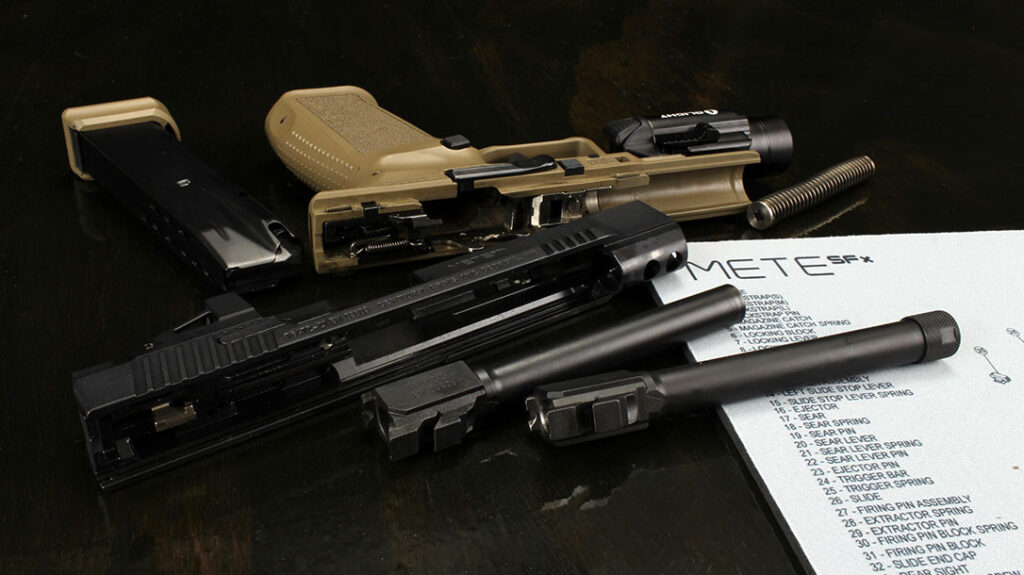
Even if you aren’t left-handed, having this lever on both sides allows you to use both your thumb and forefinger together to accomplish this task. This is a godsend for those who suffer from dexterity issues or just want that extra security on their side.
Finishing off the Ambi-suite is a reversible magazine catch. It has that same fine cross-hatching that helped make the original so easy to grab hold of. Other retained aspects include the three-slot Picatinny rail as well as the interchangeable backstrap system that allows you to make each Canik your own.
The Optic Ready METE Slide
Like all handguns, the frame is only half of the story. The slide on the METE has its improvements too. First and foremost, it comes optics-ready, and one does not have to sacrifice iron sights to install a red dot.
The METE series is cut with the RMRcc footprint and will co-witness that optic (or similar) with the iron sights. This makes zeroing a snap and allows you to present without too much alteration to your typical drawstroke.
Installation is as simple as removing the screws with the included tool and plopping your optic right in place of the cover. I installed a Shield RMSc on the SFx but left the SFT bare for comparison.
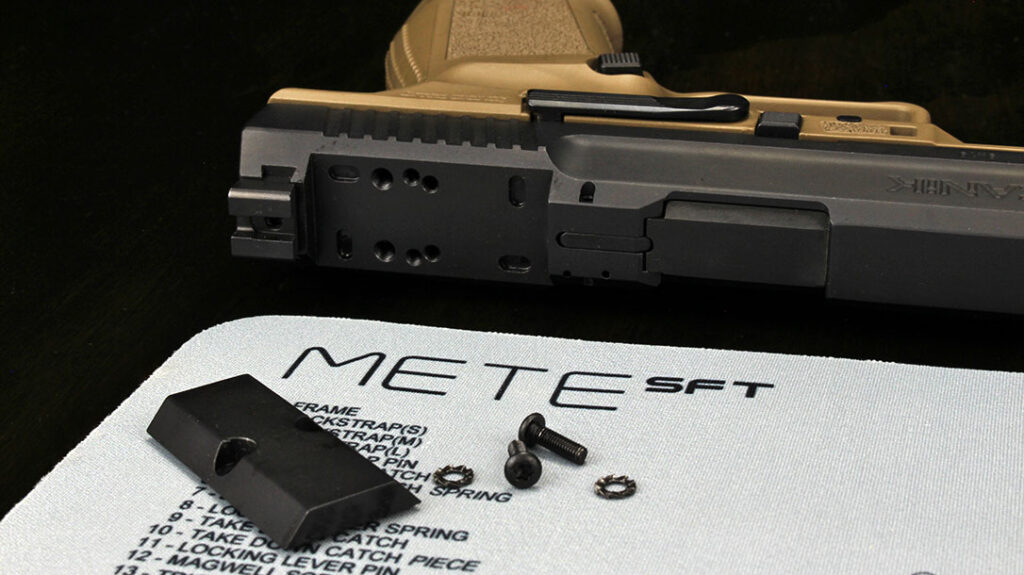
Two other mounting plates are included to help adapt to other optics. However, I think setups like this shine when using something that sits as low as possible on your irons. Speaking of irons, both METEs feature a very robust three-dot pair of sights that are fit via a common dovetail. Thus making them both adjustable and replaceable if you so wish.
Canik also made sure that the slide would be easy to manipulate by including cocking serrations both fore and aft. In addition, the company angled the rear sight forward. This provides a sturdy lip that can be racked against a rigid object if you’re down to one hand in a fight.
Running the METE SFx and SFT
Alright, enough romance. Let’s get to the range with these, right? At my disposal, I had 700 rounds of Red Army Standard ammunition. This consisted of its White Box, steel-cased fodder, as well as its Elite, which features a conventional brass casing.
I started by doing some bench-rested accuracy testing from 15 yards just to get a feel for each pistol. Not to mention ensuring that the optics and sights were as close as they needed to be.
It was during that first squeeze that I noticed how much the trigger has been improved. After checking it with my Lyman trigger scale, I confirmed both triggers had a break at 3lbs., 9oz. This is almost a full pound lighter than their predecessors.
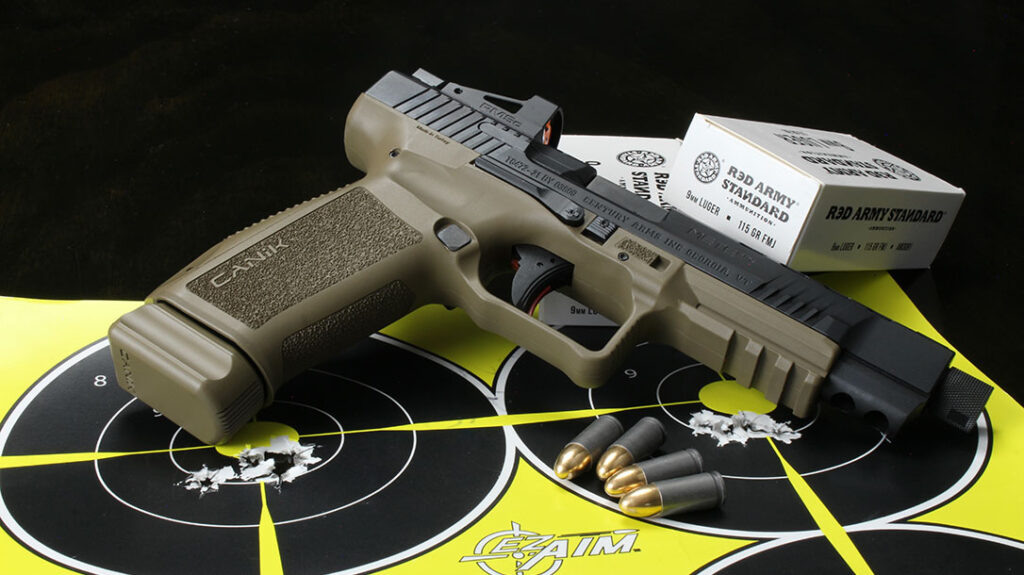
The full-sized SFx laid the rounds right on top of each other and produced groups as small as .82”, preferring the steel-cased pills. Likewise, the shorter SFT was also quite impressive with its smallest group measuring 1.95”. It demonstrated a preference for the brass-cased ammunition.
With the sights zeroed and the best ammo for each determined, it was time to put each gun to a practical test by running that trigger how it was designed to run—fast.
Decking the Pistols Out for Performance
Using the holsters that were included with my test kit, I spent some time working on my drawing and presentation. I performed this on a single 50% Allens IPSC steel target.
Canik is thoughtful enough to include an IWB/OWB holster, but it is only able to be set up right-handed. However, it is a fairly common outline, so finding southpaw holsters shouldn’t present much difficulty.

I fitted the SFx with a nice heavy OLIGHT Valkyrie flashlight to dampen the muzzle flip. And again, I left the SFT naked. My reasoning behind this is that this makes a perfect carry-optics rig, so why not set it up as such?
Best of all, each METE comes with a beveled magazine well, which is allowed in both Carry Optics and Production. However, if you aren’t competing, you can slap on the included mag well flair for even faster reloads.
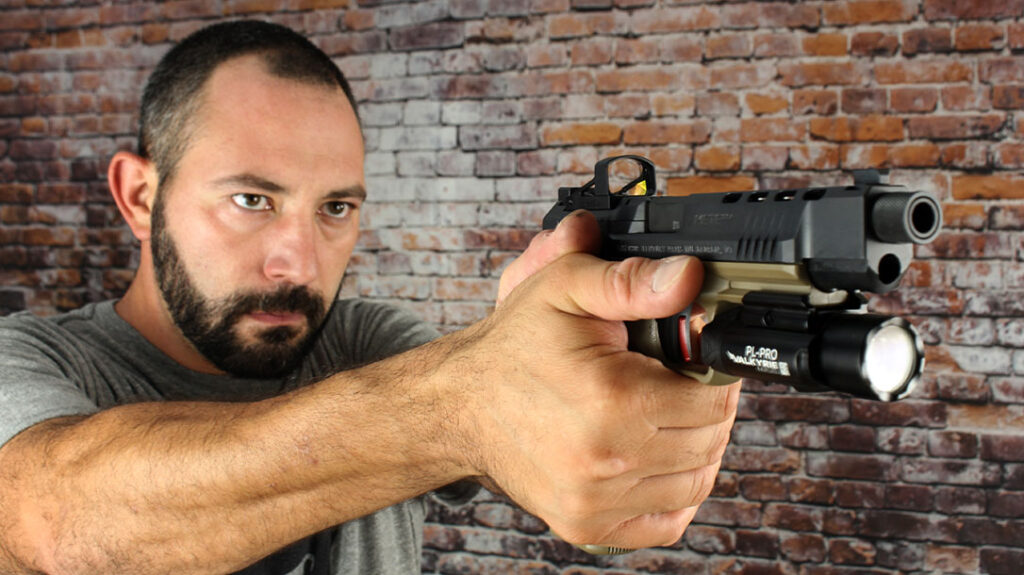
The METE Trigger
After getting my holster right where I wanted it, I filled a few mags and got to work. During my first double-tap, I was able to see the other side of the trigger improvement, the reset.
The METE pistols reset at that same stupid-short tenth of an inch. However, the upgraded hardware was far more positive than its predecessors, rocketing it back forward. This made both shots land on the target at nearly the same time.
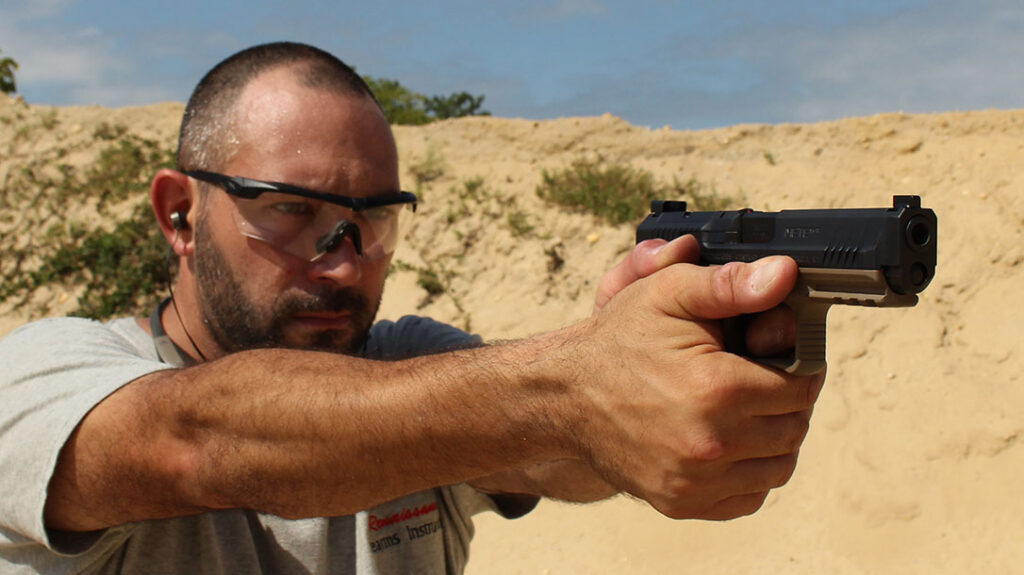
Best of all, because such little motion is required, there’s a minimal shift in your grip between the two rounds. This ensures they both land right next to each other.
During my test day, scoring double-alphas quickly became the norm, even out to distances of 18 yards. Both pistols shot and recovered like they were on rails. Finally, I didn’t experience a single failure with either, not even with the steel-case ammo.
Canik Sends the METE Pistols Ready to Run
In traditional Canik fashion, each METE comes decked out with just about everything you need to own the pistol and run it in a match. Aside from the holster, each gun comes with a cleaning kit, speed loader, and 18 and 20-round magazines. Likewise, it includes a complete tool kit and two other backstraps to mate it to your individual hand perfectly.
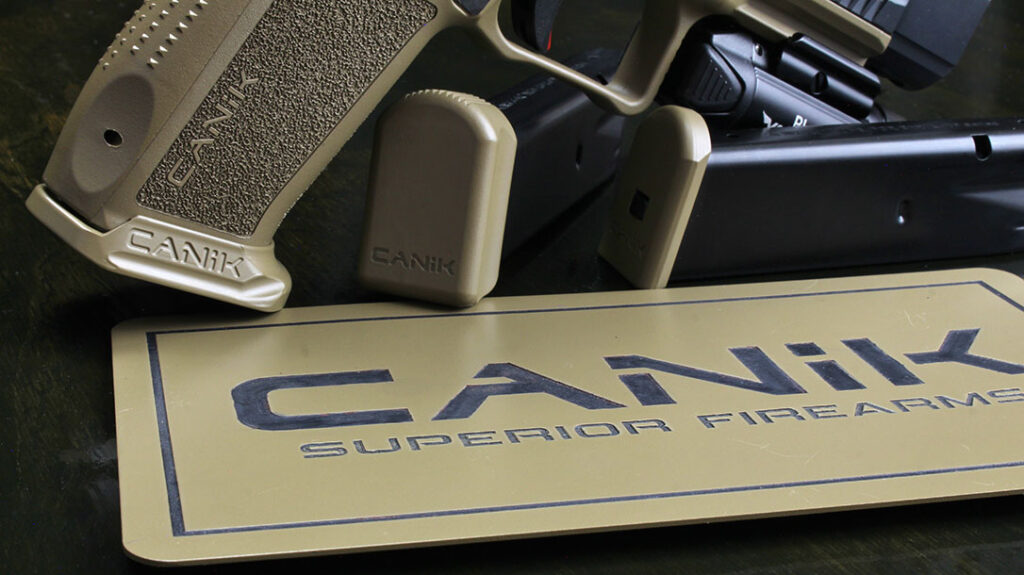
Canik is also set to offer other accessories in the future. This includes threaded barrels for both models and holsters that accommodate many different lights on the market. Regardless of what you plan to hang off your METE, one thing’s for sure—you’re going to love the way the new pistols shoot.
For more information, please visit CanikArms.com.
Canik METE SFx Specs
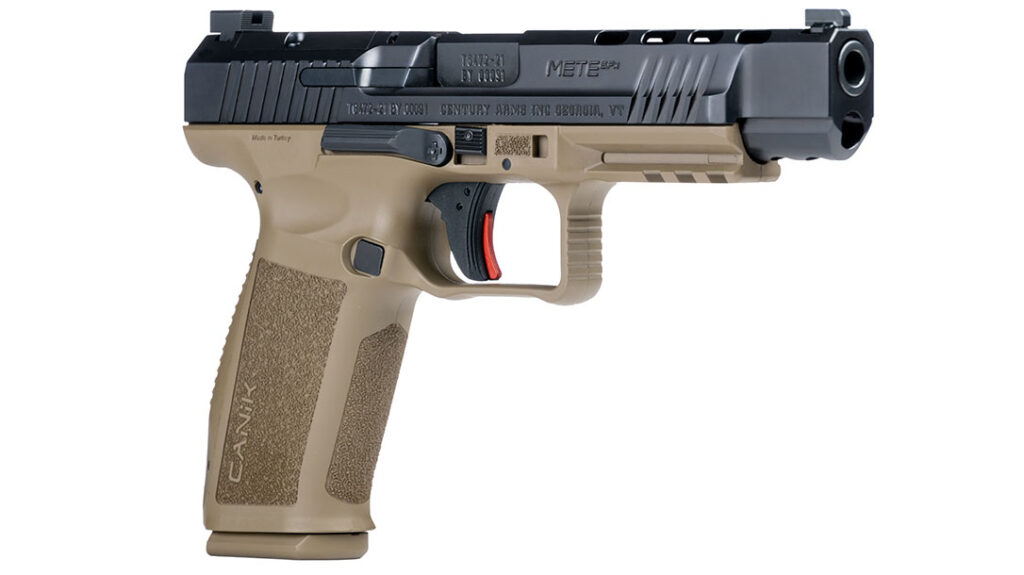
| Action | Single |
| Caliber | 9mm |
| Capacity | 20+1 |
| Barrel Length | 5.2 inches |
| Overall Length | 8.29 inches |
| Width | 1.41 inches |
| Height | 5.70 inches |
| Weight | 29.35 ounces |
| Finish | Two-Toned |
| Sights | Drift adjustable for windage. Optics Ready (RMRcc cut) |
| Trigger Pull | 3 pounds, 9 ounces |
| Magazines | 18rd. & 20rd. included (10rd. available) |
| MSRP | $574.99 |
Canik METE SFT Specs
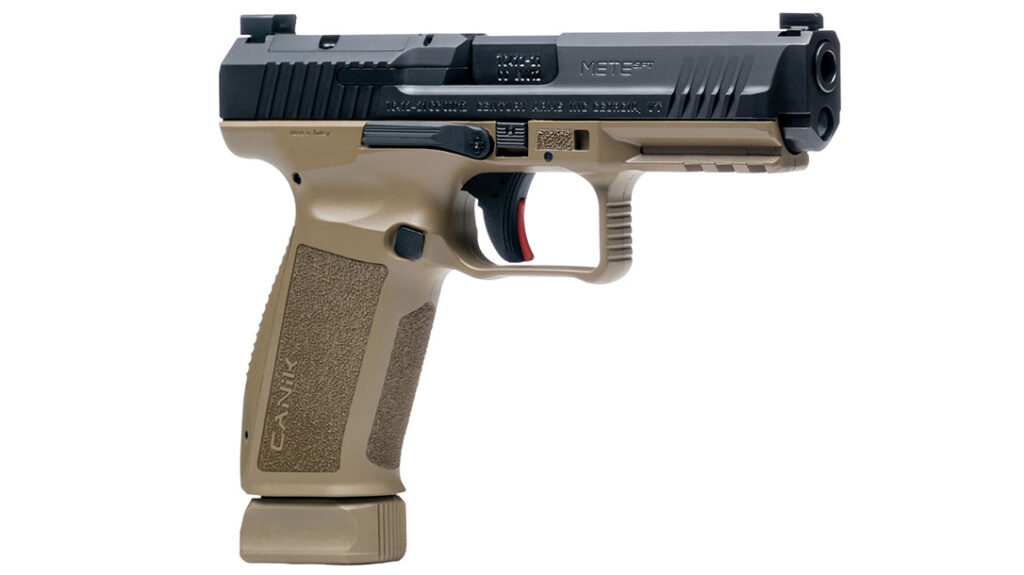
| Action | Single |
| Caliber | 9mm |
| Capacity | 20+1 |
| Barrel Length | 4.46 inches |
| Overall Length | 7.56 inches |
| Width | 1.41 inches |
| Height | 5.70 inches |
| Weight | 27.83 ounces |
| Finish | Two-Toned |
| Sights | Drift adjustable for windage. Optics Ready (RMRcc cut) |
| Trigger Pull | 3 pounds, 9 ounces |
| Magazines | 18rd. & 20rd. included (10rd. available) |
| MSRP | $519.99 |
Performance
| Canik SFT | Group Size (inches) | |
| Cartridge | Best | Average |
| Red Army Standard 124gn. FMJ – Elite Brass | 1.95 | 3.21 |
| Red Army Standard 115 gr. FMJ – White Box Steel | 2.12 | 3.68 |
| Canik SFx | Group Size (inches) | |
| Cartridge | Best | Average |
| Red Army Standard 124gn. FMJ – Elite Brass | 1.24 | 2.87 |
| Red Army Standard 115 gr. FMJ – White Box Steel | 0.82 | 1.98 |
Notes: Accuracy results for five consecutive, five-shot groups from 15 yds. off of a sandbag rest. Temperature: 78 degrees F. Humidity 70%. Abbreviations: FMJ (Full Metal Jacket),



Didn’t find what you were looking for?
Read the full article here




